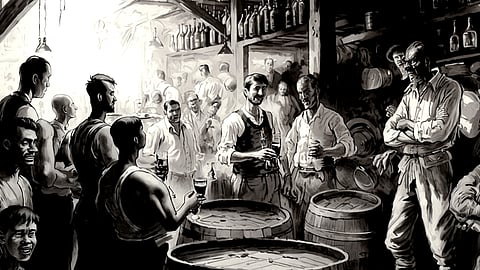- Commentary
- History Vignettes
- Notes on Culture
- Dispatches
- Podcasts
- Indian LanguagesIndian Languages
- Support

THE OTHER CLASS comprises the real drinking classes of the community. The lower class of traders and pedlars make a comfortable living, and are not bound by the scruples and observances of the true “bania.” The same may be said of the skilled labourer or artisan. It is true that the total number of drinkers is larger in the ordinary labouring classes and drinking is much more prevalent among what may be called the mechanic class.
The distillers, or Kalwars, are 1,081 in number. The total number of this caste at the last census was 30,806. There is no doubt that every man in the caste drinks, and the number of men may be estimated at 6,000. Many are employed in the various stills and shops, and in nearly every case, the owners are also Kalwars. For other castes all round, we may estimate that there are at least five drinkers to every one recorded debtor. If that estimate is made, we arrive at a drinking population of about 76,500 out of an adult male population of about 5,23,000.
Besides the Kalwars, the other traders in this class are: metal vessel makers (226), oilmen (335), grain parchers (157), paan sellers (44), and tobacco sellers (3.) The vessel-makers are more numerous in the city and the large towns of the distillery tract. The oilmen and grain parchers are found everywhere, but not all of them follow their own trade.
Of the mechanical castes, the potters give most drinkers—663 in all. Next to the potters come goldsmiths (494), blacksmiths (168) and jewel-threaders (125).
In the next class, there are 543 Bhars, or woodmen, 203 cowherds and 122 goatherds. Of the hunting tribes, the Bahelias number 24, and the Musahirs 126. There are also 148 Nats or strolling acrobats, 12 Badhiks or reformed dacoits, 4 Banjaras, and 102 Doms.
The total number of Doms in the Gorakhpur district is only 1,400, of whom about 250 are adult males not in jail. The principal reason of the large numbers of Doms in prison is their arrears. That is, the money they owe for purchasing drinks, which they have not paid. As they are mere beggars, they are seldom able to pay at all; but their vocabulary of abuse is large and their character is the lowest. And so, the shopman gives them a peace-offering, and puts it down on the chance that some day he may be paid.
The labouring classes comprise the four great groups of carriers, bearers, toddy gatherers and boatmen (chamars, kahars pasis and mullahs.) These, with their subdivisions, have 3,590, 497, 762, and 1,773 drinkers, respectively.
The chamar and pasi groups are spread over the whole Gorakhpur district evenly.
The kahars are relatively numerous in the city, for the palki is still a fashionable mode of transportation here. Servants are mainly taken from the turaha subdivison.
The boatmen are found mainly along the navigable rivers in the south of the district, and among them, the kewats (who are also agricultural labourers) are the men most given to drinking.
The remaining labouring castes are saltpetre workers who have 185 drinkers, beldars with 161, porters with 62, and grass cutters with 39.
Of the men classified as being in domestic employment, the larger portion are barbers, washermen, gardeners, tailors and leaf-plate makers. The rest is made up by a few sweepers, family-bards, and singers and dancers. All the washermen are great drinkers, and over the greater part of the district, the barbers are nearly as bad.
The mendicant class is made up of fakirs, gosais, saints, sadhus, atiths and jogis.
There only remains the question: who are the consumers of European liquor? The answer cannot be given with detailed accuracy. It may be said roughly that many well-to-do, town-bred people, who are not overburdened with religious scruples, drink it. Unorthodox Musalmans often prefer English liquor, but Kayasthas and banias are the main consumers.
The Kayasthas furnish nearly all the clerks in the public offices, and a very large portion of the local bar, and their example has had its effect even on a few Brahmans. The only other consumers are a few blacksmiths, carpenters and banias, who may be contractors or master-men and have acquired the taste by association with Europeans and Eurasians in the course of their work.
Concluded
The Dharma Dispatch is now available on Telegram! For original and insightful narratives on Indian Culture and History, subscribe to us on Telegram.
